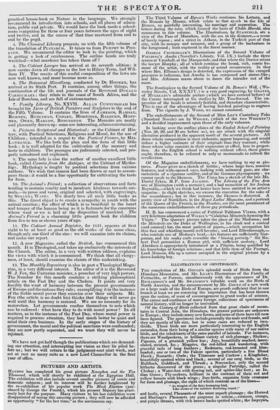PICTURES AND ARTISTS.
HayrioN has completed his great picture Xenophon and the Ten Thousand, which will shortly be exhibited at the Egyptian Hall. The exhibition will also include several smaller pictures of comic and domestic subjects ; and its interest will be further heightened by the re-exhibition of his popular work The Mock Election (pur- chased by George the Fourth), which his present Majesty has graci- ously lent for the purpose. Many visitors to his last exhibition were disappointed of seeing this amusing picture ; they will now be afforded an opportunity "for the last time," as the auctioneers say. The Third Volume of Byron's Works continues his Letters, and the Memoir by Moons, which relate to- that epoch is the life of Bvnost, so painfully interesting, his marriage and separation. The letters during the tour, which formed the basis of Childe Harold, also commence in this volume. The Illustrations, by STANFIELD, are a view of the Pass of Marathon, with the sea in the distance,—a scene of lovely repose ; and a street in Athens, in the Turkish part of that city, with its mosque and minaret, and a group of the barbarians in the foreground ; both engraved in the finest manner.
GEORGE CRUIKSRANK'S Illustrations of the Second Volume of FIELDING'S Amelia (Novelist's Library, Vol. IX.) include the three scenes at Vauxhall, at the Masquerade, and that where the Doctor seizes the lawyer Murphy; all of which combine the broad, rich, comic hu- mour of the artist, with the reality of actual occurrences. In that where Mrs. Ellison's design is detected, the expression of the enraged procuress is ludicrous, but Amelia is too composed and statue-like; and Mrs. Atkinson seems about to dance the intruder out of the room.
The frontispiece to the Second Volume of St. .Ronan's Well, (Wa- verley Novels, Vol. X X XIV.) is a very good engraving, by GRAVES, of MULREADT'S admirable picture (which we have noticed before) of the Curate interrupted at his studies by Mr. Touchwood. The ex- pression of the heads is minutely faithful, and therefore characteristic. This is one of the advantages of having finished paintings to engrave from. The vignette by J. Woon, we cannot commend.
The embellishments of the Second of Miss LEE'S Canterbury Tales (Standard Novels) are by Warcirr, (which of the two Waintas?) and a decided improvement upon those of the early volumes.
In looking over the outline plates of the English School of Painting (Nos. 28, 29, and 30 are before us), we are struck with the singular alteration produced in the apparent merit of the several pictures. All those whose composition is most elaborate, appear imposing, and would induce a higher estimate of their originals than they warrant; while those whose value consists in their expression or effect, lose in propor- tion. As the English school is nothing without effect, these plates ought, therefore, to be referred to only as memoranda to refresh the recollection.
Of the Magazine embellishments, we have nothing to say as pic- tures. Fraser gives us a sketch of Gathe ; whose large face, massive features, and wide-opened eyes, looking with animated gaze, are cha- racteristic of a vigorous senility, and of the German physiognomy : we cannot speak to the likeness. The Union has a sketch of the late Mr. Daniel Sykes, M. P. from JACKSON. The Library of the Fine Arts one of Bonington (with a memoir), and a bad mezzotint of Sir Joshua Reynolds,—which we think had better have been omitted in an artist's magazine : in slight sketches, we excuse the execution for the sake of the resemblance ; but in this instance, the likeness is distorted. A pretty view of Northfieet, in the Royal ladies' Magazine, and a portrait of the 'Queen of the French, in the Boudoir, are the most prominent of the numerous embellishments of these gay periodicals.
H. B. has commenced a series of Political Tableaux Vivans, with a very felicitous adaptation of WILKIE'S "Calabrian Minstrels hymning the Virgin." The Queen's picture takes the place of the Madonna; and the Minstrels are the Duke of Wellington, in his cloak and a conical (and comical) hat, the most patient of pipers,—which occupation his thin face and whistling mouth well become ; and Lord Ellenborough,-:-. who reminds one of Medusa's head,—his features are sufficiently Gor- gonian, and his snaky curls resemble the "hissing periwig." Sir Ro- bert Peel personifies a Roman girl, with sufficient modesty ; Lord Aberdeen is appropriately introduced as a Pilgrim, being qualified by his knowledge of foreign relations ; and that little item of the Peerage, Lord Monson, fills up a corner occupied in the original 'picture by a down-looking boy.


























 Previous page
Previous page